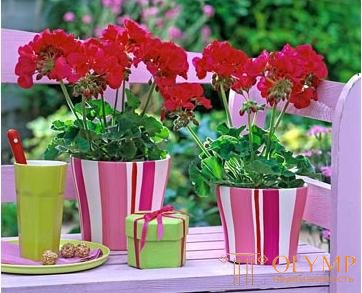
Latin name: Pelargonium
Family: Geranium - Geraniaceae
Homeland: Yu. And Yu.Z. Africa, Asia Minor and Afghanistan, Australia and New Zealand
Growing up: For a beginner
Lighting: Bright light
Humidity: Moderate

Description:
Surely everyone is well aware of the red geranium in a pot - the favorite of our grandmothers. I must say that this universally recognized attribute of the bourgeoisie coziness still adorns the window sills not only of the inhabitants of our country, but also of the Europeans. That's just the correct name of this flower - pelargonium, and the variety of its modern varieties and their color can be envied by anyone. In addition, it is now customary to grow it not on the windowsill, but in the garden or on the balcony.
Different varieties of geraniums (or pelargoniums) bloom in greenhouses, winter gardens, on our window sills: ivy-shaped, large-flowered English, fragrant with carved leaves, a variety with the smell of nutmeg or orange, apples and others. Small ampelous bushes with very beautiful star-shaped flowers and lush ivy-like leaves are especially nice to me.
In addition to its beauty, geranium creates a positive aura around itself. It is easy to care for, it is rarely exposed to diseases, requires moderate watering and not too nutritious earthen mixture, resistant to drought, has a high resilience. However, you should follow certain rules for the cultivation and care of these charming plants.
Not surprisingly, Pelargoniums in the whole world are so fond of. They are easy to care for, easy to propagate, they bloom for a long time with large and colorful inflorescences.
In winter, the pot with geraniums should be kept in a cool place at a temperature of 8-10 ° C, in no case allowing overflow, overmoistening of the soil in autumn and winter. Pelargonium is propagated most often by cuttings (processes), less often by seeds. The cuttings are carried out in February-March or in summer, in June-July.
Until late autumn blooming geraniums. In winter, when there is a lack of light and high temperature, the bushes are drawn out, lose their decorative effect, the stem becomes bare and the plant stops flowering. In the spring they carry out a transplant, spraying the leaves with water is not allowed. With the onset of warm, sunny days, pots with geraniums are brought to fresh air, choosing a well-lit place. From this point on, she will once again delight us with her elegant bouquets, filling the house with aroma (which, by the way, scares off pests), bringing peace and tranquility.
Game: Perform tasks and rest cool.12 people play!
Play gameLocation
light, sunny. produced, in the summer the plant is carried out to fresh air, but to a shady place. Pelargoniums contain in winter at a temperature of 10-15 degrees.
Lighting
Bright light
Watering
Game: Perform tasks and rest cool.12 people play!
Play gameAir humidity
Moderate
Care
Geraniums respond positively to mineral and organic fertilizing in the spring-summer period. To form a bush, pruning or nibbing should be done, although geranium does not like frequent and hard pruning.
Breeding
All geraniums are easily propagated by cuttings throughout the year, the most favorable time for cutting is February-March and July-August. It is better to resume geranium, cutting off the apical shoot for rooting. When grafting, cut cuttings are first slightly dried and planted in the substrate, kept dry (they are rarely watered and not sprayed).
Transfer
Every year, young geraniums must be replanted. This is done in the spring before growth. The capacity for the roots should be small, otherwise leafy shoots will develop strongly, but the plant will not bloom. A mixture of sod, leaf, humus soil and sand is suitable for cultivating geraniums (2: 2: 2: 1)
Что бы оставить комментарий войдите
Комментарии (0)